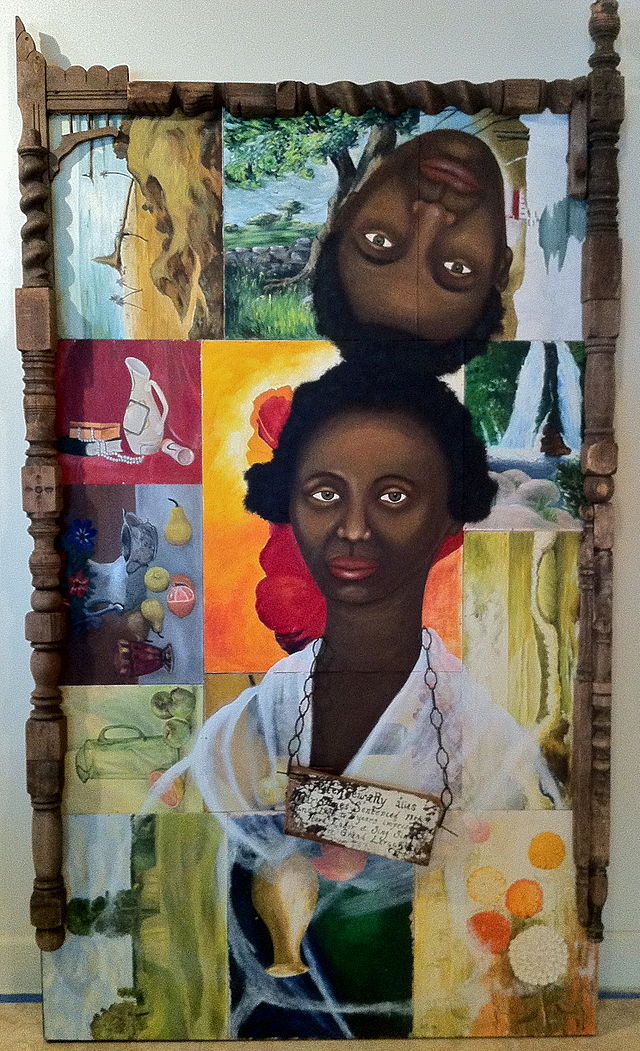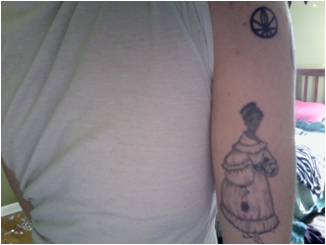Difference between revisions of "4: The Man-Monster's Legacy"
| Line 6: | Line 6: | ||
Imagination and reenactment have taken over where the historical record ends, as we see in three examples of contemporary artists who draw upon Sewally's story and the Man-Monster print. | Imagination and reenactment have taken over where the historical record ends, as we see in three examples of contemporary artists who draw upon Sewally's story and the Man-Monster print. | ||
| − | |||
=Lezley Saar's Portrait= | =Lezley Saar's Portrait= | ||
| Line 18: | Line 17: | ||
| − | [[File:Saar | + | [[File:Saar image011.jpg|640px]] |
| − | |||
=Anarchy Andi's Tatoo= | =Anarchy Andi's Tatoo= | ||
| − | + | In homage to Sewally, Anarchy Andi flaunts the imputed stigma of queerness back at society, as the print itself becoming part of hir "rig" with which to go "sailing along the street." | |
| − | + | [[File:Andi image014.png|550px]] | |
| Line 35: | Line 33: | ||
---- | ---- | ||
| − | =End of Exhibit= | + | =End of Man-Monster Exhibit= |
| − | + | To return to the introduction to the exhibit or to earlier sections see below: | |
=[[Visualizing the Man-Monster: Peter Sewally/Mary Jones, New York City, 1836]]= | =[[Visualizing the Man-Monster: Peter Sewally/Mary Jones, New York City, 1836]]= | ||
Revision as of 11:21, 30 June 2011
Continued from: 3: Questions for Viewers
Though mocked, imprisoned, and rendered "notorious" in his own day, Sewally has recently become an important person in queer, black, and transgender history, and his story has inspired artists.
Imagination and reenactment have taken over where the historical record ends, as we see in three examples of contemporary artists who draw upon Sewally's story and the Man-Monster print.
Lezley Saar's Portrait
Lezley Saar's larger than life-sized mixed-media portrait of Sewally was inspired by the artist's encountering the Man-Monster print in Charles Addams' Dear Dead Days, a book of historical oddities and anomalies published in 1959.
Knowing little else about his story than what the image and caption provided, Saar's portrait nonetheless intuits several key truths about his story as we now know it. Placing a convict's plate around his neck, she likens the print to a modern day "mug shot."
But this is a double portrait, as Sewally's other face appears upside down and to the right, his other body floating mysteriously upwards and off the canvas. Neither body is the true Sewally and one is impelled to re-orient ones gaze to see it all. Saar's poetic image places Sewally/Jones in a space between genders.
Anarchy Andi's Tatoo
In homage to Sewally, Anarchy Andi flaunts the imputed stigma of queerness back at society, as the print itself becoming part of hir "rig" with which to go "sailing along the street."
Vaginal Davis's Performance
Vaginal Davis, performance artist and queer curator, has lectured about Peter Sewally, the "She-Monster of Olde New York" as she calls him, and aspires to play him/her on screen.
<ADD DAVIS PICTURE>
End of Man-Monster Exhibit
To return to the introduction to the exhibit or to earlier sections see below:
Visualizing the Man-Monster: Peter Sewally/Mary Jones, New York City, 1836
1: The Man-Monster Story
2: The Man-Monster Lithograph
3: Questions for Viewers
The Producers of the Man-Monster Exhibit

